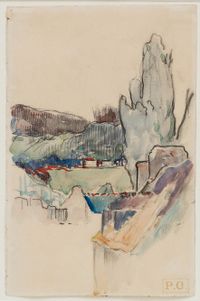Paul Gauguin was a Post-Impressionist painter and woodcut printmaker, but it is as a Symbolist that he became hugely influential on the early Cubists, Fauves, Nabis, and early Expressionists. What excited them were his formal innovations, mixed with a passionate interest in South Pacific tribal culture—and with the woodcuts, a calculated technical crudity.
Read MoreThough born in France, Gauguin spent his childhood in Peru. Between 1865 and 1871 he was a sailor, but he then became a stockbroker, while starting to paint part-time and building up a collection. He then married Mette, a Danish woman, in 1873 and moved to Denmark to sell tarpaulins, but was not a successful salesperson. He could not speak Danish and Mette supported him by working herself.
The marriage lasted eleven years, the stock market crashed, and Gauguin struggled to survive as a painter. He soon joined a circle of Impressionist painters and met Camille Pissarro, Edgar Degas, Émile Bernard, Georges Seurat, and Paul Cézanne, some of whom he later fell out with. His sister, Marie, supported him.
After splitting from his family in 1886, Gauguin moved to Brittany, where he developed an interest in the experimental use of colour, flattened space, and expressively distorted form. He also began drawing in pastel. To close supporters like Émile Schuffenecker he explained, 'Art is an abstraction. Develop it from nature by dreaming in front of it, and pay more attention to the process of creation than the result... by creating as God creates.'
Gauguin then briefly visited the Panama and the Caribbean, where he became fascinated by the Indigenous culture and began using Symbolist imagery and incorporating Christian elements as in Hail Mary (1891). He strived for a synthesis similar to what he saw in the literary avant-garde, where the formal elements merged with the dominant idea or feeling (Vision After the Sermon, 1888).
In 1888, Gauguin went to Arles, where he formed a tempestuous friendship with Vincent van Gogh and his brother Theo. He moved to Pont-Aven, and in 1889 he explored a Cloisonnist use of black outlines, intense colour (Yellow Christ, 1889), and ignoring perspective. He also learned a lot from his friend and fellow artist, Edgar Degas.
Profoundly disenchanted with Western culture, deeply hostile to industrialisation, and impressed by the otherworldly nature of the South Pacific, Gauguin went to Tahiti in 1891 after a successful fundraising auction. He settled in Mataiea, where he lived in a bamboo hut. Besides prolifically painting and woodcut making, he carved sculpture. He was mesmerised by the possibilities of non-western 'primitive' Tahitian society—then already much influenced by French colonialism and missionary culture—and struck by the beauty of the women.
His friends lent Gauguin some books on Tahiti's abandoned culture and history, and these further sparked his imagination. To his friend Charles Morice in 1890 he stated, 'Primitive art originates in the mind and puts nature to its use.'
In 1893 Gauguin went back to France and continued painting and printmaking (Auti te Pape, 1893–1884). Attempts in France at reconciliation with Mette were a disaster, but friends supported him, even though he was bitterly criticised by Parisian society. On one occasion he got into a brawl, acquiring a shattered ankle that never healed.
Thinking it had more promise than France where he felt despised, Gauguin eventually returned to Tahiti in 1895 to live in Papeete (Two Tahitian Women, 1889) but was shocked by the French influence. In 1901 he moved to the Marquesas Islands, to Atuona on Hiva-Oa, where he built a studio. However, his deteriorating health from syphilis and the painful ankle resulted in his death in 1903. Paradoxically, Gauguin's work was then starting to be successfully promoted by his dealer Ambroise Vollard, attracting acclaim he had never experienced when alive.
John Hurrell | Ocula | 2021




